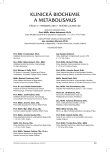The precision and bias of measurement methods according to EP15 A3
Authors:
J. Ambrožová 1; J. Kratochvíla 2
Authors place of work:
OKB-H Nemocnice Prachatice, a. s
1; SEKK Pardubice
2
Published in the journal:
Klin. Biochem. Metab., 24, 2016, No. 4, p. 183-190
Summary
EP15-A3 document [1] deals with the procedures designed to determine the quantitative measurement procedures analytical performance, namely the user precision verification and the bias estimations that CLSI presents in the form of the recommendations for user as to achieve both goals within a single experiment, which at a minimum allowable range (design) 5x5 takes five days. The paper topic is concerned on the practical user experience with the procedures according to [1], demonstrated here on the albumin example in Annex [11] and identifying the key differences as to the practices described in the previous the EP15-A2 (version A2). A special part of the study presents a comparison of some calculations according to [1] conducted by the means of common Excel software spreadsheets compared with the calculations generated by the special Excel software supplement, namely by the MSA of Analyse-it version 4.51. Two summary tables demonstrate the bias estimates of twenty basic biochemical analytes and eleven specific proteins based on the seven different reference materials measurements.
Keywords:
EP 15-A3, precision verification, trueness estimations, MSA (Analyse-it) application.
Zdroje
1. EP15-A3: User Verification of Precision and Estimation of Bias. Approved Guideline – Third Edition. CLSI 2014.
2. TNI 010155:2009. Mezinárodní metrologický slovník – Základní a všeobecné pojmy a přidružené termíny (VIM3).
3. Fraser, C. G. Biological Variation: From Principles to Practice. AACC Press Washington DC, 2001.
4. Ricós, C., Álvarez, V., Cava, F., García-Lario, J. V., Hernandéz, A. et al. Current databases on biological variation: pros, cons and progress. Scand. J Clin. Lab. Invest 1999, 59, p. 175–84.
5. Desirable biological variation database specifications. Accessible 22.1.2016 from: http:// www. Westgard.com/biodatabase1.htm.
6. Rustad, P. Reference intervals for 25 of the most frequently used properties in clinical chemistry. Proposal by Nordic Reference Interval Project (NORIP), Fürst Medical Laboratory, Oslo. Accessible 22.1.2016 from: https://dl.dropboxusercontent.com/u/6149066/NORIP/index.htm.
7. Petersen, P. H., Whicher, J. T., Johnson, M., Itoh, Y., Carlström, A. B. et al. Strategy for Determinig racial and environmental similarities and differences for plasma proteins, Clin. Chem. Lab. Med. 2001, 39(11), p. 1146-1153.
8. Perich, C., Minchinela, J., Ricós, C., Fernández-Calle, P., Alvarez, V. et al. Biological variation database: structure and criteria used for generation and update. Clin. Chem. Lab. Med., 2015, 53(2), p. 299-305.
9. Analyse-it. Verze 4.5.1, doplněk software MS Excel. Accessible 22.1.2016 from: http://analyse-it.com.
10. Synek, V., Plzák, Z. Odhad nejistoty chemických měření se započtením vychýlení. Metodický list 16. Eurachem CZ, 2016. Accessible 1.2.2016 from: http://www.eurachem.cz/metodicke-listy.php
11. Annex článku „Preciznost a bias metod měření dle EP15-A3“ – Bulletin FONS 3/2016 resp. http://www.nempt.cz/komplement/oddeleni-klinicke-biochemie-hematologie/Annex
Štítky
Biochémia Nukleárna medicína Nutričný terapeutČlánok vyšiel v časopise
Klinická biochemie a metabolismus

2016 Číslo 4
Najčítanejšie v tomto čísle
- Preciznost a bias metod měření dle EP15-A3
- Metabolismus bilirubinu a jeho biologické účinky
- Nové trendy v imunochemii
- Porovnání stanovení katalytické koncentrace ALP rutinní metodou ALP (Roche Diagnostics) a metodou Alkalická fosfatáza (BLW Diagnostics)
